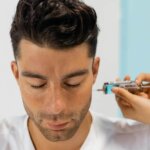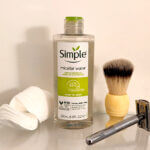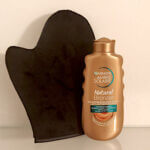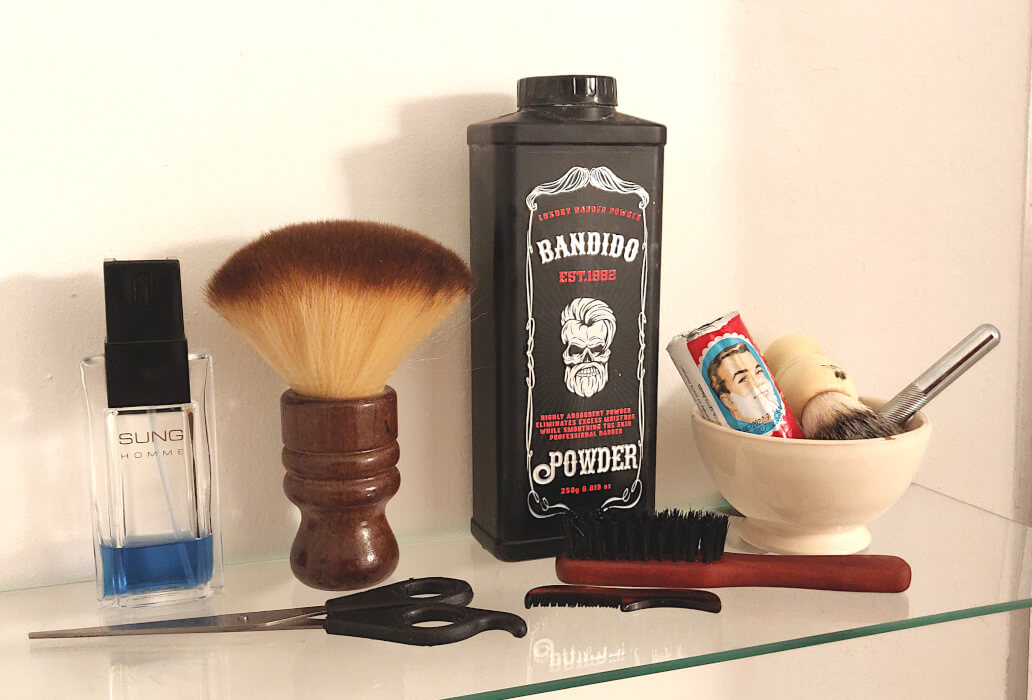
Learn what barber powder really is, how it works, how to use it, and how to make your own for a smoother, cleaner finish.
For the sake of convenience, I usually trim the few remaining hairs at the sides and back myself. I’d probably go to the barber more often if it left me looking more groomed than I can manage at home, but that doesn’t seem to happen nowadays.
Maybe it’s down to aging.
Or did something else change?
What’s Missing at the Barbershop?
Due to hygiene regulations, my barber is no longer allowed to use a neck duster. Instead, he removes loose clippings from my nape and ears with a blow-dryer. There’s no need for him to aim it at my face since there’s no hair at the crown that could land there.
Then why did he used to go over my face and dome with his neck duster?
The answer is barber powder.
He’d sweep my nape and ears with a dab of talc, then glide the brush over my face with whatever remained.
The subtle mattifying effect gave a cleaner, fresher appearance.
What Is Barber Powder For?
Search the internet for “barber powder,” and you might think it’s some sort of hair texturizer, volumizer, or dry shampoo. It’s none of these. Worse still, its true purpose is mentioned only in passing, if at all.
Traditionally, it’s made from talc, but it’s more often cornstarch nowadays—we’ll look into that in a moment.
Combined with kaolin clay, these compounds absorb moisture and oil from the skin, allowing the neck duster to lift loose hairs more readily in order to sweep them away.
They also leave the skin feeling smoother, which brings us to their next function: calming and clarifying post-shave with antibacterial zinc oxide and the soothing, hydrating effects of aloe vera and/or allantoin.
Are Barber Powder and Body Powder Interchangeable?
Formulated for use on the face and neck, barber powder is finer textured than body powder and more discreetly scented.
While similar in base ingredients, body powder is designed for sweat-prone areas and often includes stronger deodorizing agents like menthol, camphor, or synthetic fragrances that can irritate facial skin.
In other words, you can use barber powder on your body, but you shouldn’t use body powder on your face.
Talc or Cornstarch?
Talc
With its finer texture and dry, non-tacky finish, talc is ideal for the face.
Not only does it mattify; it resists moisture reactivation, remaining stable throughout the day. This is ideal in warm conditions and for acne-prone skin. It’s also non-comedogenic, meaning it won’t clog pores.
In case you’re worried that it might contain asbestos, modern cosmetic-grade talc is sourced from deposits where contamination is geologically unlikely. It’s then rigorously tested to confirm purity. In regulated markets like the US and EU, this verification is mandatory.
Cornstarch
Cornstarch is often preferred due to the above-mentioned safety concerns.
From a cosmetic point of view, it’s more absorbent than talc but leaves a less refined finish and can clog pores.
Beware, too, that as a carbohydrate, it may ferment on the skin. Therefore, think twice before applying a pure product straight from your kitchen cupboard.
Instead, mix with baking soda when applying as an underarm or foot deodorant, and with non-nano zinc oxide for the face and other body areas. I’ll give some mixing ratios later on.
A good alternative to cornstarch is rice starch. It’s finer textured and non-comedogenic. You won’t find it in commercial barber powder, but you can easily make your own; there’s a recipe at the end of this post.
Expiration
Depending on how often you intend to use barber powder, consider its longevity.
Talc-based products are inert and do not support microbial growth. If stored in a cool, dry place, they may last for several years. However, talc is sensitive to humidity and can absorb ambient odors over time.
Cornstarch-based powders, being organic, have a shelf-life of 1–2 years. They’re more prone to microbial growth and clumping if exposed to moisture, so proper storage is essential.
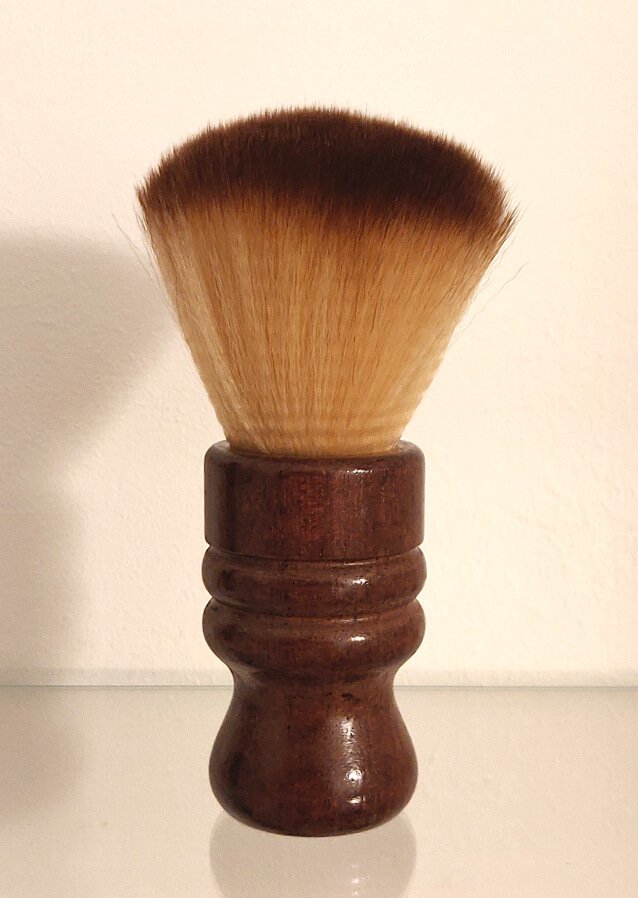 Source: The Neat and Tidy Man
Source: The Neat and Tidy ManHow to Use Barber Powder
How many of us actually realized we were being powdered after a haircut? It was so subtle, it didn’t even show up on dark whiskers.
Yet the effect was significant.
A more generous application was necessary after shaving, but it still wasn’t enough to make a man appear powdered or suppress his natural skin tone.
What You Need
For the same minimal effect, invest in a round neck duster. You’ll find one with synthetic bristles for under ten dollars on Amazon.
If you’re acne-prone, cotton pads may be more beneficial for the face—I’ll show you how later.
For the underarms, I recommend a cotton ball or an old shaving brush. Whatever you do, don’t apply with the same tool you use for your face; even after washing, the armpits continue to harbor bacteria and may be prone to warts. A powder spray bottle with a rubber bulb pump avoids skin contact altogether.
Otherwise, use your hands from the neck down, standing in the shower or tub to avoid mess.
1. Protecting Shirt Collars
Barbers applied powder to more effectively rid the neck of loose hairs. You can do the same to save your dress shirts from the grimy ring that typically accumulates around the collar.
The cause is sebum, which men produce at high levels from adolescence to old age. Powder absorbs it and forms a barrier.
It also guards against friction and chafing: ideal for sensitive skin, especially if you wear close-fitting collars.
A light dusting is enough—you don’t need to apply so much that it leaves white marks on darker garments.
2. As an Aftershave Finishing Product
Due to its calming effect, barber powder is particularly beneficial if you shave with multi-blade cartridges. Unlike straight and safety razors, these cut below the skin’s surface, often causing irritation and razor burn.
Barber powder soothes, leaving the skin less reactive and visibly smoother.
3. As a Pre-Electric
If you shave either your face or head with an electric razor, use barber powder as a pre-shave.
It protects foils and rotary blades from sebum buildup, prevents drag, and minimizes irritation on sensitive or freshly cleansed skin.
And because a matte surface reveals contours and missed patches more clearly, it improves visibility.
4. As a Mattifier
Apply barber powder wherever you want less shine, whether it’s your whole face or just your forehead and nose.
After sweeping the neck duster over your nape and throat, go over your face with whatever remains on the brush. This takes off shine without making you look ghostly.
Having said that, even if you do apply a little too much, your natural oils should revive your skin tone within minutes. Otherwise, mist your face with water.
Barber powder can also reduce shine on a bald crown, as well as soothe after wet-shaving your head.
If your looking to enhance head shine, I’ve covered that in another post.
For Acne-Prone Men
For acne-prone skin and large pores, apply barber powder with lint-free cotton pads. Being disposable, these are more hygienic than a brush and leave a natural-looking finish.
Sprinkle the powder into your palm or onto a tissue, pick up with a cotton pad, and pat into your face from forehead to neck until any chalkiness has vanished. Replace the pad as soon as its fibers loosen—this will happen several times during a single application.
A fragrance-free product may be preferable, especially if your skin is reactive or prone to irritation—or if you find the scent of traditional barber powders too intensive.
5. Barber Powder for the Whole Body
When using barber powder on your whole body, pay particular attention to high-sweat areas like the back, chest, groin, armpits, and feet.
If you’re prone to chafing, powder forms a dry barrier that helps reduce friction. Apply under close-fitting clothing, and between the thighs when walking, running, or cycling. This is especially important during warmer weather when perspiration and humidity increase skin sensitivity.
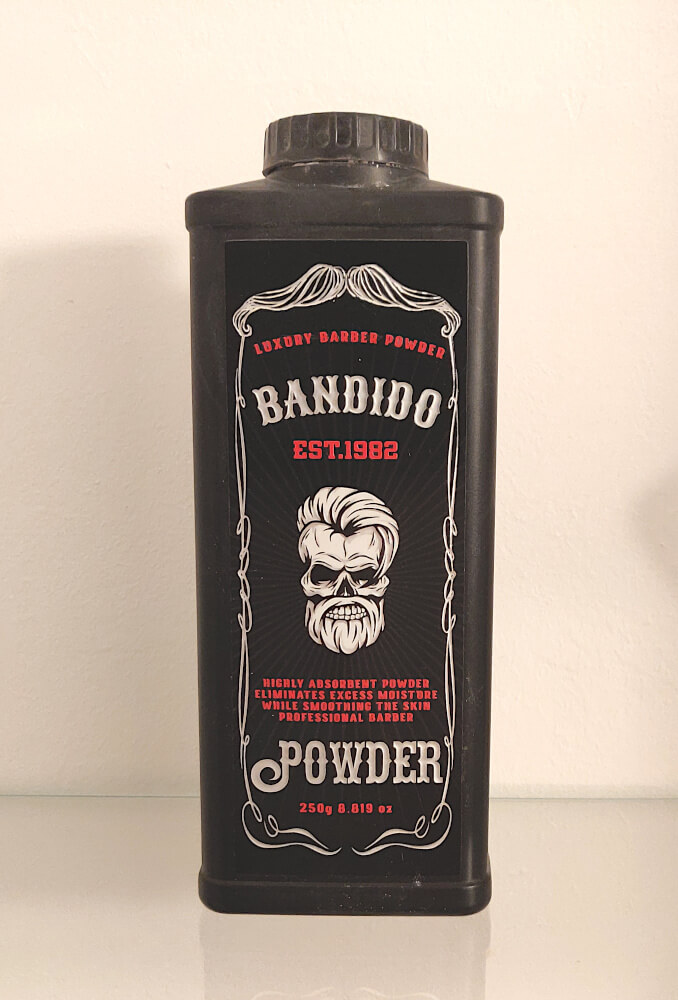
Mixing Barber Powder or Pure Cornstarch with Baking Soda
To enhance deodorizing power, mix barber powder or pure cornstarch with baking soda in a 1:1 ratio.
This works well for the feet and underarms, balancing dryness with odor control.
Use the same ratio when mixing cornstarch with non-nano zinc oxide for other body areas.
Making Your Own Barber Powder
Barber powder is very easy to make, enabling you to choose your scent and adjust ingredients according to your skin’s needs.
Ingredients
- 2 parts rice starch or cornstarch
- 1 part non-nano zinc oxide
- Optional: ½ part kaolin clay (absorbs oil; omit for dry skin)
- Optional: ¼ part allantoin powder (calms irritation, improves skin texture, and moisturizes. Omit for acne-prone skin unless it’s sensitive)
- Optional: 1-2 drops essential oil for every 100 g of powder. Sandalwood, lavender, cedarwood, bergamot, and tea tree are safe and masculine.
Instructions:
- Blend thoroughly, ideally in a food processor or blender.
- Transfer to a dry container or shaker.
- If adding essential oils, allow 24-48 hours to mellow before use.
© 2025 J. Richardson
Related Posts
Disclaimer
The information provided by The Neat and Tidy Man (“we,” “us,” or “our”) on theneatandtidyman.com (the “site”) is for general informational purposes only. While we endeavor to keep the information up to date and correct, we make no representation or warranty of any kind, express or implied, regarding the completeness, accuracy, reliability, suitability, adequacy, validity, or availability of any information on the site. Under no circumstance shall we have any liability to you for any loss or damage of any kind incurred as a result of the use of the site or reliance on any information provided on the site. Your use of the site and your reliance on any information on the site is solely at your own risk.

